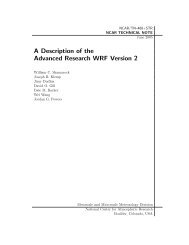You also want an ePaper? Increase the reach of your titles
YUMPU automatically turns print PDFs into web optimized ePapers that Google loves.
that the MODIS-based categories should only be used with the Noah land surface model<br />
in <strong>WRF</strong>.<br />
WPS<br />
The 20-category MODIS-based land use data may be selected instead of the USGS data<br />
at run-time through the geog_data_res variable in the “geogrid” namelist record. This is<br />
accomplished by prefixing each resolution of static data with the string “modis_30s+”.<br />
For example, in a three-domain configuration, where the geog_data_res variable would<br />
ordinarily be specified as<br />
geog_data_res = ‘10m’, ‘2m’, ‘30s’<br />
the user should instead specify<br />
geog_data_res = ‘modis_30s+10m’, ‘modis_30s+2m’, ‘modis_30s+30s’<br />
The effect of this change is to instruct the geogrid program to look, in each entry of the<br />
GEOGRID.TBL file, for a resolution of static data with a resolution denoted by<br />
‘modis_30s’, and if such a resolution is not available, to instead look for a resolution<br />
denoted by the string following the ‘+’. Thus, for the GEOGRID.TBL entry for the<br />
LANDUSEF field, the MODIS-based land use data, which is identified with the string<br />
‘modis_30s’, would be used instead of the ‘10m’, ‘2m’, and ‘30s’ resolutions of USGS<br />
data in the example above; for all other fields, the ‘10m’, ‘2m’, and ‘30s’ resolutions<br />
would be used for the first, second, and third domains, respectively. As an aside, when<br />
none of the resolutions specified for a domain in geog_data_res are found in a<br />
GEOGRID.TBL entry, the resolution denoted by ‘default’ will be used.<br />
Selecting Static Data for the Gravity Wave Drag Scheme<br />
The gravity wave drag by orography (GWDO) scheme in the <strong>ARW</strong> requires ten static<br />
fields from the WPS. In fact, these fields will be interpolated by the geogrid program<br />
regardless of whether the GWDO scheme will be used in the model. When the GWDO<br />
scheme will not be used, the fields will simply be ignored in <strong>WRF</strong>, and the user need not<br />
be concerned with the resolution of data from which the fields are interpolated. However,<br />
it is recommended that these fields be interpolated from a resolution of source data that is<br />
slightly lower (i.e., coarser) in resolution than the model grid; consequently, if the<br />
GWDO scheme will be used, care should be taken to select an appropriate resolution of<br />
GWDO static data. Currently, five resolutions of GWDO static data are available: 2degree,<br />
1-degree, 30-minute, 20-minute, and 10-minute, denoted by the strings ‘2deg’,<br />
‘1deg’, ‘30m’, ‘20m’, and ‘10m’, respectively. To select the resolution to interpolate<br />
from, the user should prefix the resolution specified for the geog_data_res variable in<br />
the “geogrid” namelist record by the string “XXX+”, where XXX is one of the five<br />
available resolutions of GWDO static data. For example, in a model configuration with a<br />
48-km grid spacing, the geog_data_res variable might typically be specified as<br />
geog_data_res = ‘10m’,<br />
<strong>WRF</strong>-<strong>ARW</strong> V3: User’s <strong>Guide</strong> 3-21

















